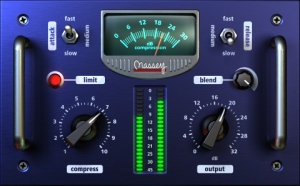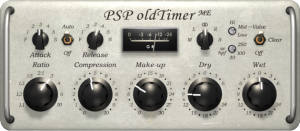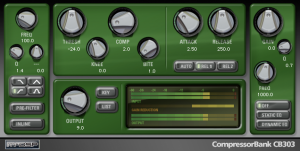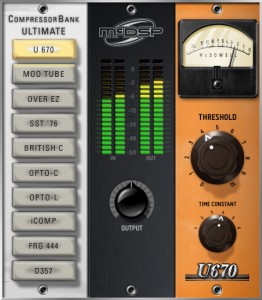Compressor Plugin Roundup: Alternative Workhorses
Last month, we brought you a roundup of some of the best extreme and unusual compressor plugins on the market. In that feature, we looked at the kinds of dramatic sound-shaping dynamic tools that are worth owning, but that you might not use on every mix.
Today, we present the inverse: A few of our favorite everyday workhorse compressors that are available for your DAW. Rather than sum up the biggest names in the field, we decided to take a closer look at a handful of the best cross-platform offerings from smaller brands. It begins with a two-man shop.
Massey CT5
After a nearly year-long wait, Massey has finally released the much-anticipated update to their CT4 compressor. The original version inspired a kind of fevered loyalty that’s uncommon for compressor plugins that are designed to sound as transparent and unobtrusive as the CT4.
Part of that can probably be attributed to this small company’s reputation for affordable pricing and a customer-centered approach. But a large portion of the CT4’s success lies in the fact that users found it very hard to make this plugin sound bad.
It may not always add much mojo to the source, but as far as effective, pleasant-sounding dynamic control goes, the CT4 offered a great alternative to the clean compressor plugins designed by some of the longtime leaders like Sonnox and Waves. And, unlike the Oxford and Renaissance Compressors made by those companies, the CT4 offered a simple, intuitive analog-style GUI.
Now with the new CT5, Steven Massey has tweaked the plugin and added new controls, taking his compressor from useful to indispensable in the process. Although I enjoyed the original CT4, I’ll be the first to admit that it had its limiting factors. Thankfully, the most substantial of those have been largely corrected with latest update.
The CT5 adds a “medium” attack setting that allows this plugin to complement a far wider variety of sources. With the CT4, there were often times when the attack envelope I desired was just out of reach. Also new to the plugin is a limiter function, and a blend knob – a feature which has become nearly ubiquitous on new software compressor designs.
The official word from Massey is that the underlying algorithm remains largely unchanged. However, I believe I do hear a slight change in the sound. Although the design is still certainly a transparent one, with CT5, I hear the subtle – and admirable – tone of the plugin as soon as it’s instantiated on the track, before I even move a single knob. The VU meter seems to reflect this as well. Take the plugin out of bypass, and even with the controls set to minimum, the GR needle dances ever-so-gently to the beat.
Softube Tube Tech CL1B and Summit TLA 100A
Softube’s emulation of the Tube Tech CL1B is an everyday workhorse with heaps of character. Like all of Softube’s designs, even the GUI is rich, luscious and fun to look at. But far more than looks, it’s the sound of this virtual unit that’s unmistakably analog.
Even the gain control on the Softube CL1B sounds pretty good. A simple boost here seems to add tone as much as it adds volume. And ultimately, this plugin’s real strength lies in its ability to impart subtle body and gloss when compressing by just a few dB at a time.
When the CL1B digs in deeper than that, the sound of the plugin can become a bit grainy and saturated – but in a way that sounds authentic to me rather than inadvertent. It has a sound – much like the hardware it’s modeled after – that’s a useful and colorful alternative to vintage-minded workhorses like the LA-2A and its many copies.
But the CL1B isn not Softube’s only worthwhile venture into opto-style compressor emulations. Their rendition of the Summit TLA-100A fills in wherever the CL1B misses.
While it may be significantly less colorful than the Tube Tech CL1B, Softube’s Summit TLA-100A can deliver extreme levels of compression while staying largely transparent – just like the original hardware. It’s a natural everyday compressor for vocals, bass and acoustic guitars in particular, and can deliver heaps of dynamic control without significantly reshaping the tone of the source.
PSP oldTimer and BussPressor
While the Softube plugins that made this list model specific hardware units, PSP were content to imagine their own when they set out to create the affordable and popular oldTimer plugin.
What PSP lacks in GUI design here, they make up for in sound. The oldTimer has a bit of a Fairchild character – but not quite; a bit of an LA2A tone – but not exactly. At high gain-reduction levels it has just a touch of analog graininess, but stays smoother and more even, perhaps, than the CL1B.
This is not a glossy-sounding plugin by any means, but it rarely offends unless you intend it to. The oldTimer manages to reach a level of balance between grit and unobtrusiveness that’s difficult to achieve. It has personality, but rarely overwhelms. It sounds good on all manner of acoustic instruments, voice and clean electric guitars. And as a tool, it’s about as useful as a Phillips head screwdriver.
PSP’s BussPressor, which we reviewed in July, is a snappy, sinewy and flexible compressor inspired by the sound of SSL consoles. I’ve had great luck with it on drums, mix buss and some acoustic instruments. Once again, it’s a plugin that seems to find it’s way onto nearly every ITB mix.
Although I prefer the targeted approach of these two units, PSP also offers a plugin called the MixPressor, that’s designed for flexibility and seems to have a loyal following of its own.
McDSP Compressor Bank, Channel G and 6030 Ultimate Compressor
When McDSP emerged in 1998, the field of plugin developers was much smaller than it is now.
Waves and Sony were around, making a handful of forward-looking designs, and Dave Amel’s Bomb Factory had just gotten its start modeling vintage processors for an increasingly digital world.
Colin McDowell, meanwhile, decided that McDSP would do both of those things.
His now-classic Compressor Bank offered a multi-functional compressor similar to those being sold by Waves and Sonnox early on. The CB1, CB2 and especially, the CB3, were the kinds of tools that would only be truly feasible in the software world.
The CB4, however, was an earnest effort to model the specific vintage squeeze-boxes that users lusted after, limitations and all. Those models sound great even now.
Eventually, McDSP took the research that went into these algorithms and put them together with their flagship Filter Bank EQ and the flexible console and tape machine emulations from their Analog Channel, in order to create Channel G – a one stop shop for organic-sounding signal processing.
Unlike the other entries on this list, what makes McDSP fit here is not that they offer a single sound that works in so many places. Instead, each of their dynamics plugins is really a whole suite of tools – an entire palette of colors ready to be explored. While this is a key selling point for Channel G, Analog Channel and Compressor Bank, there is no place where this approach is more clear – or more simply executed – than in the 6030 Ultimate Compressor.
The 6030 is like a box full of crayons. It offers 10 different colors, each with a distinct personality, and encourages visceral, gutsy decision making. The layout is like a virtual 500-series lunchbox stuffed to the brim with boutique compressors that would easily run several hundred dollars a piece if sold as discrete hardware. But instead, this single plugin with its minimal, intuitive interface and cornucopia of distinctive models costs just $250 in its native version.
The models inside include compressors inspired by a Fairchild, LA2A, 1176, Vari-Mu and dbx, plus a few wholly original designs. Like classic hardware, each module has a minimalist layout. Some have just one or two knobs, and the busiest of the bunch have four.
As for the sound, each one is distinctive, although it’s apparent that they are “inspired by” more than they are faithful re-creations of classics. By and large, the individual compressors in the 6030 sound just a touch bigger, more modern, and more “hi-fi” than both the CB4 models, and the original hardware on which they’re based. Depending on your tastes (and your mix) that could be desirable.
Like any tool, this one isn’t perfect, or else, why would anyone own more than more? Most notably, the output section of the 6030 could use a little refinement to make level-matching a little quicker for AB listening. But plop this plugin on an insert, and it would be difficult to imagine an engineer who would be unable to find a sound in the right ballpark for the track.
Although almost any one of the modules in the Ultimate Compressor would be worth considering for this list on its own, when you put them all together, the 6030 transcends “workhorse.” It is a true swiss-army knife.












Etienne P
October 2, 2012 at 9:02 pm (12 years ago)Great to hear about these alternatives. I already have a lot of respect for Mcdsp and Softube. In the same vein, I also love the devil loc by Soundtoys, using the crunch button. It makes drum rooms mics pumping in a really good way. It’s intended first to be a saturation plug, but you can use it also to compress without making it distorting. It is not complete and versatile as the ones you mentioned in your article.
thanks Justin for these cool suggestions.
Etienne P.
http://www.mixingforindies.com
Scott Walker
October 2, 2012 at 9:04 pm (12 years ago)You have to check out the Stillwell Major Tom. It’s a great dbx-ish comp. I use it all the time.
Guest
October 28, 2013 at 1:03 pm (11 years ago)http://www.stillwellaudio.com/plugins/stillwell-audio-plugins/major-tom-program-dependent-compressor/
Stillwell’s Major Tom is my go-to nearly all the time. Definitely worth a demo.